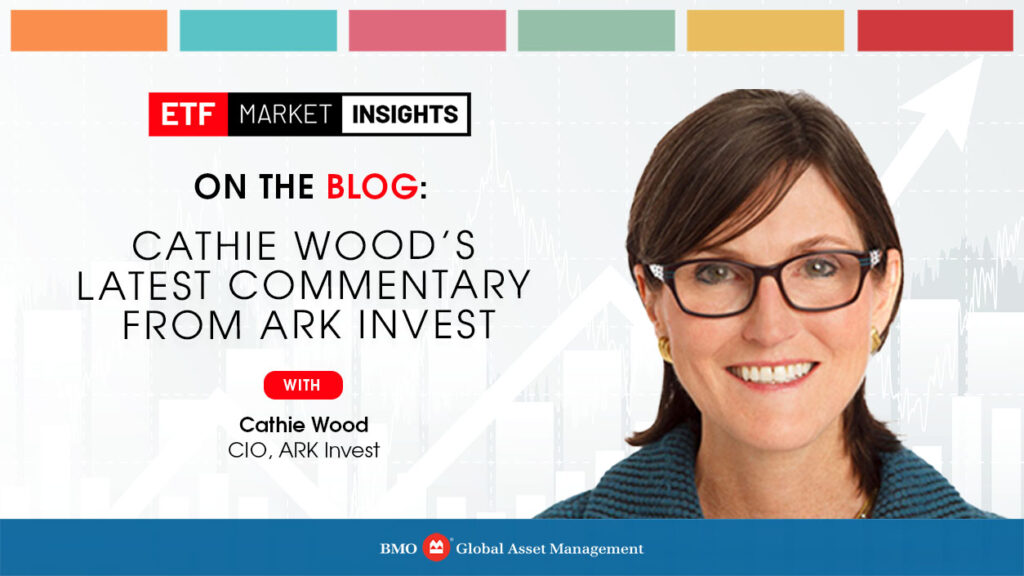
Commentary as of Jul 17, 2024
Broad-based global equity indexes1 appreciated in the second quarter even as the U.S. Federal Reserve (Fed) refrained from committing to the timing and pace of future rate cuts. While the Fed’s rhetoric generally has been hawkish, some members are beginning to part company with the consensus. Chicago Federal Reserve Bank President, Austan Goolsbee, recently stated that the Fed should prepare for rate cuts if inflation continues to fall to 2% on a year-over-year basis.
While the consensus forecast is for a soft landing, ARK still expects that a loss of pricing power will force corporations into employment cutbacks that will perpetuate the rolling recession2 that began in the spring of 2022 when the Fed embarked on a 22-fold increase in interest rates. In response, housing, autos, commercial real estate, and capital spending have capitulated as inventories continue to build. In ARK Invest’s view, the Five Innovation Platforms3 around which ARK has centered its research and investing could play an outsized role in pulling the economy out of recession, salvaging corporate margins as inflation gives way to deflation in many sectors during the next few years.
Rolling recessions suggest that the Fed should weigh the merits of rate cuts sooner than the “dot plots” have been suggesting
While the Fed still is focused more on the inflation side of its dual mandate than on employment, the Bureau of Labor Statistics (BLS) has revised nonfarm payroll statistics down for thirteen of the last sixteen months, suggesting that the labor market is weakening much faster than government reports have suggested. The last time the BLS revised nonfarm payroll employment down for such a long time was in 2007, right before the Global Financial Crisis (GFC). Supporting this point of view is the following evidence:
- The auto industry faced significant challenges during the COVID-19 pandemic and, while sales did enter a V-shaped recovery in 2021, current unit sales are annualizing at a 15.3 million4 rate, well below the pre-COVID range of 17-18 million units. In the early days of the pandemic, autos accounted for roughly one-third of the inflation spike. Now, used car prices are down 9% year-over-year and 24% below peak prices.5
- Housing metrics like median prices, housing starts, and affordability also are sending troubling signals. At 4.1 million units, the number of existing home sales is not far above levels last seen during the global housing crisis.6 Nationwide, rents are declining roughly -0.7% year-over-year.7 At the same time, a historically high number of apartment units under construction suggests that rents will push inflation into much lower-than-expected territory during the next year.
- Real Gross Domestic Income (GDI)—which should equal real Gross Domestic Product (GDP) over time—suggests that the economy is meaningfully weaker than Real GDP has been depicting. The near-record difference is ~$520 billion.8 Many global company bellwethers are corroborating this weakness, having reported year-over-year revenue declines during the first quarter: 3M (-0.3%), UPS (-5.3%), Kraft-Heinz (-1.2%), Exxon Mobil (-3.9%), Thermo Fisher (-3.4%), Home Depot (-2.3%), Cisco (-12.8%), Texas Instruments (-16.4%), partly because of weakness in the rest of the world.
- After boosting profitability with higher prices during the supply-chain-related bottlenecks in 2021-22, and again as unit growth disappointed in 2023, corporations now seem to be losing pricing power, to the detriment of profit margins. Already, companies like Amazon, Nike, Starbucks, and McDonald’s have launched discount campaigns to win back consumers. As measured by Bloomberg, the S&P 500’s gross margin declined from 34.6% on average during the past five years to 33.7% during the second quarter of 2024. In our view, this setback will intensify until the Fed cuts interest rates significantly and unless companies harness innovation like artificial intelligence aggressively, not only to drive productivity growth but also to create new products and services that replace legacy solutions. To limit the damage to margins in the interim, companies that hoarded employees during post-COVID labor shortages are likely to lay them off during the next year—and lower wage gains—further allaying the Fed’s concern about underlying inflation. As a result, nominal activity could weaken beyond the recent soft spots associated with housing, autos, and other big-ticket purchases, forcing more price cuts and margin compression.
- As measured by the National Federation of Independent Business (NFIB), Small Business Optimism in the US is in recession territory, lower not only than that seen during the COVID recession and the saving and loans crisis, but also lower than during the GFC.9 Small businesses are the primary drivers of job creation, so plummeting confidence suggests that the labor market is much weaker than headline figures suggest.
- M210 growth turned negative on a year-over-year basis from December 2022 through March 2024 and, at 0.6%, is still extremely weak by historical standards. While sequential declines seemed natural after the COVID-related surge, continued weakness could be pointing to recession. Additionally, because rising mortgage rates have trapped homeowners in their homes, growth in the velocity of money seems to be slowing down and could exacerbate the impact of declining M2, raising the odds of broad-based price deflation.
- The ratio of the Commodity Research Bureau (CRB) Metals price index to the Gold price index has dropped to lows not seen since the GFC in 2008-2009. Until the Fed started raising rates in 2022, this ratio had been correlated closely with long-term interest rates. If this relationship were to revert to normal, interest rates could collapse, or metals prices could rise significantly, or some combination of both.
The bond market has been signaling trouble ahead
From March 2021 to July 2023, the yield curve11 inverted from +159 basis points to -108 basis points,12 hitting the steepest levels since the early 1980s when the Fed was fighting double-digit inflation. Since July 2023, the yield curve has entered a bear steepening phase, with long-term rates increasing relative to short-term rates, lowering the inversion to -35 basis points,13 still suggesting that both real growth and inflation could surprise on the low side of expectations. The Federal Reserve began increasing interest rates when the year-over-year Consumer Price Index (CPI)—a lagging economic indicator—reached 8.5% on a year-over-year basis in March 2022. Shortly thereafter, geopolitical pressures and inventory hoarding pushed the CPI-based inflation rate to 9.1% on a year-over-year basis. Since then, CPI inflation has dropped to 3.0%,14 thanks to various deflationary forces––good, bad, and cyclical.
The Federal Funds Target Rate surged 22-fold in little more than a year. The deflationary ramifications of current Fed policy already are surfacing through bankruptcies in commercial real estate, both office and multi-family, and could culminate in another round of regional bank failures. If the Fed were to lower interest rates in response, companies sacrificing short-term profitability to invest and potentially capitalize on technologically enabled exponential growth opportunities should be prime beneficiaries.
Disruptive Technologies & The Importance of Diversification
The Fed paused its tightening moves last summer. At the same time, in the technology realm, ChatGPT began to dramatize the seemingly miraculous breakthroughs that are likely to tip the scales even further toward broad-based deflation. Although creative destruction—the transition from gas-powered vehicles to electric vehicles, for example—could obfuscate the boom associated with AI and other disruptive technologies evolving today, the waves of growth associated with the convergence among the 14 technologies involved in our five major platforms—robotics, energy storage, AI, blockchain technology, and multiomics sequencing—should start moving the needle on macro metrics increasingly and significantly during the next five to ten years.
Meanwhile, the equity market has reached record-breaking levels of concentration, spurring our search for diversified exposure to the AI revolution, particularly software applications that our research indicates are underrepresented in broad-based benchmarks but likely to drive value creation over our investment horizon. In our view, history will show that inflation—initially triggered by supply shocks—was transitory and evolved into disinflation, then ultimately deflation. Consequently, interest rates are likely to surprise on the low side of expectations, broadening the equity rally from a narrow subset of stocks and reinforcing the need for diversified AI investments. If ARK is correct that the most important AI investment opportunities are associated with “disruptive innovation,” then the winners and losers are likely to be surprising, resulting in a more diverse set of winners to which current equity market concentration should give way.
During the second quarter of 2024, BMO ARK ETFs underperformed the broad-based global equity indexes15.
BMO ARK Next Generation Internet ETF (ARKW)
BMO ARK Genomic Revolution ETF (ARKG)
1 As measured by the S&P 500 and MSCI World.
2 ARK’s Five Innovation Platforms are Artificial Intelligence, Robotics, Energy Storage, Multiomic Sequencing and Blockchain Technology.
3Manheim Used Vehicle Value Index. Data as of June 2024.
4 WARD’s Automotive Group. Data as of June 2024.
5 National Associate of Realtors. Data as of May 2024.
6 Apartment List National Rent Report. Data as of July 2024.
7 U.S. Federal Reserve Economic Data as of March 2024. GDP is the total market value of all finished goods and services produced within a country’s border within a specific time period, typically a year. GDI is a measure of the total income generated by a country’s economy within a specific time period, typically a year.
8 National Federation of Independent Business. Data as of May 2024.
9 M2 is a measure of the U.S. money stock that includes M1 (currency and coins held by the non-bank public, checkable deposits, and travelers’ checks) plus savings deposits (including money market deposit accounts), small time deposits under $100,000, and shares in retail money market mutual funds.
10 As measured by the difference between yields on the 10-year Treasury bond and the 2-year Treasury note.
11 An “inversion” means that the long-term Treasury yield is lower than the short-term Treasury yield. The yield difference was +159 basis points on March 29, 2021, and -108 basis points on July 3, 2023. One basis point is equal to 1/100 of a percentage point, or 0.01%.
12 The yield different was -35 basis points on June 28, 2024.
13 U.S. Bureau of Labor Statistics. Data as of June 2024.
14 Broad-based global equity indexes are defined as the S&P 500 Index and the MSCI World Index.
15 BMO ARK Next Generation Internet ETF (ARKW) Annualized Performance NAV as of July 31st, 2024, of 19.01% 1Y, 7.04% YTD and 63.10% Since Inception (November 15, 2022). BMO ARK Genomic Revolution ETF (ARKG) Annualized Performance NAV as of July 31st, 2024, of -25.48% 1Y, -14.37% YTD and -20.25% Since Inception (November 15, 2022). BMO ARK Innovation ETF (ARKK) Annualized Performance NAV as of July 31st, 2024, of -5.63% 1Y, -9.75% YTD and 18.96% Since Inception (November 15, 2022).
Disclaimers:
This article is for information purposes. The information contained herein is not, and should not be construed as, investment, tax or legal advice to any party. Particular investments and/or trading strategies should be evaluated relative to the individual’s investment objectives and professional advice should be obtained with respect to any circumstance.
The viewpoints expressed by the author represents their assessment of the markets at the time of publication. Those views are subject to change without notice at any time. The information provided herein does not constitute a solicitation of an offer to buy, or an offer to sell securities nor should the information be relied upon as investment advice. Past performance is no guarantee of future results. This communication is intended for informational purposes only.
Risk Profile – Comprised of a client’s risk tolerance (i.e. client’s willingness to accept risk) and risk capacity (i.e. a client’s ability to endure potential financial loss)Commissions, management fees and expenses all may be associated with investments in exchange traded funds. Please read the ETF Facts or prospectus of the BMO ETFs before investing. Exchange traded funds are not guaranteed, their values change frequently and past performance may not be repeated.
For a summary of the risks of an investment in the BMO ETFs, please see the specific risks set out in the BMO ETF’s prospectus. BMO ETFs trade like stocks, fluctuate in market value and may trade at a discount to their net asset value, which may increase the risk of loss. Distributions are not guaranteed and are subject to change and/or elimination.
BMO ETFs are managed by BMO Asset Management Inc., which is an investment fund manager and a portfolio manager, and a separate legal entity from Bank of Montreal.
“BMO (M-bar roundel symbol)” is a registered trademark of Bank of Montreal, used under licence.



















































